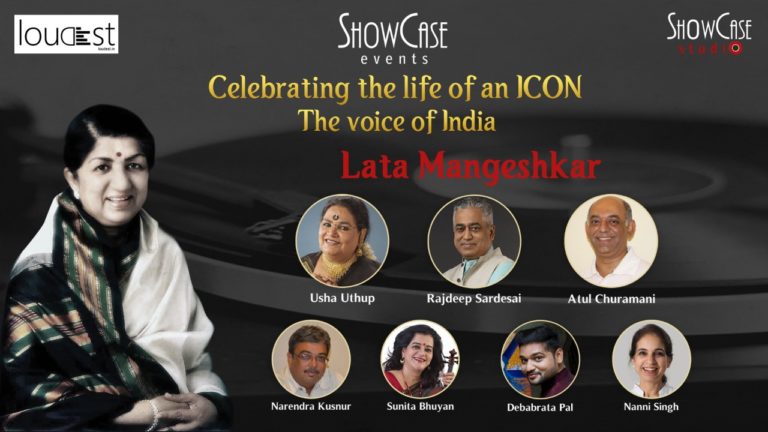By Noor Anand Chawla
If Indians were to be collectively defined as one voice, its representation would surely be that of the iconic Lata Mangeshkar. Upon her recent demise, the country collectively mourned the death of this legendary singer with an outpour of tributes. No tribute, however, would be complete without a significant musical aspect. This is why ShowCase Events, ShowCase Studio and BusinessWorld Loudest collaborated to bring together a panel of industry stalwarts and luminaries in the field of music for their show, ‘Celebrating the Life of an ICON: The Voice of India, Lata Mangeshkar’.
The show took place on the ShowCase Events Facebook and YouTube pages on Sunday, February 13. Though it was streamed Live, its recording is available for viewers to watch any time. In it, Nanni Singh, CEO of ShowCase Events hosted a number of special guests that included famed singer Padmashri Usha Uthup, MD of Turnkey Music and Publishing Atul Churamani, senior music journalist Narendra Kusnur, Assamese fusion violinist and singer Sunita Bhuyan, and visual storyteller Debabrata Pal. Journalist Rajdeep Sardesai also sent in a heartfelt anecdote to add to the mix.
The virtual event was a soulful one indeed, opening with a picture montage dedicated to Lata ji, before the audience was regaled with Sunita Bhuyan’s rendition of ‘Lag Ja Gale’ on the violin.
Opening the evening, Nanni Singh shared, “A voice that gave solace, soothed the depressed, put infants to sleep, woke a sleeping person, romanticised a lover, inspired a soldier, healed the sick… is now no more, but she has left behind a vast legacy. Here today is a gathering of people to share her journey, memories attached to her, and of course her beautiful songs and incidents that were so special to us. She had a song for every age, every emotion, and every feeling… that is how we all remember Lata Mangeshkar.”
Then Singh called Usha ji to the floor, who declared with feeling, “Lata ji was the voice of dozens of the best-known faces on screen. The sheer volume of her work is incredible. Her style, in fact, became the benchmark by which the industry judged singers in coming years. I have always been in awe of her. There was tremendous admiration and respect, even though our genres were poles apart. Her work will always live on.”
Adding to this, Atul Churamani said, “I feel very blessed that I’m in an industry where I could be in the same room as someone like Lata ji! She was warm and gracious, and when you were with her, you knew you were in the presence of greatness. I also admired the fact that she was very curious and wanted to learn about new technologies and new ways.” For some musical respite from the chatter, Bhuyan then regaled the audience with a lovely Assamese song about a small village in Assam, which was originally sung by Lata ji to Bhupen Hazarika’s music.
Narendra Kusnur then quipped, “In my initial years, I used to avoid interviewing her because I was so completely in awe of her! Honestly though, apart from her musical legacy, there were so many interesting aspects of her personality. She was fond of cricket, had a vast collection of non-film music, devotional music, and so much more. Even though I have written a number of articles on her, there is still so much more I could write. The catalogue of her work is endless – it’s almost unbelievable!”
At this point, quite aptly, Singh played Rajdeep Sardesai’s video tribute which he had sent in earlier. He too recounted her fondness for cricket and his family’s long-standing association with her owing to the common ties with India’s favourite game. The next musical interlude was again by Bhuyan who played ‘Dil Hoom Hoom Kare’ from the national-award winning film Rudaali – another powerful number sung by Lata ji and composed by Bhupen Hazarika.
As the vibrant discussion and musical performances went on, artist Debabrata Pal silently worked his brush in the background. Quite miraculously, in that little time, he painted a fantastic ode to Lata ji, inspired by her life and music. He also linked the artwork to the evening’s guests in subtle ways. His art takes inspiration from the teachings of the
Upanishads, where colours and symbols hold significant meaning. He refers to this as Raga Chitra or visual storytelling.
This was followed by a beautiful rendition of Lata ji’s ‘Ajeeb Dastaan Hai Ye’ by Usha ji, and the evening drew to a close with each guest defining Lata ji in one sentence. While Bhuyan quoted P L Desphande, for whom there was God and then there was Lata Ji’s sur; Churamani called her immortal, as she lives on through her music; Kusnur described her as the epitome of perfection, dedication, timelessness, and purity; and Pal called her blessed as god’s favoured ‘Swar ki Samragini’. Usha ji summed it best by saying, “She was perfectionin ebony and ivory.”



